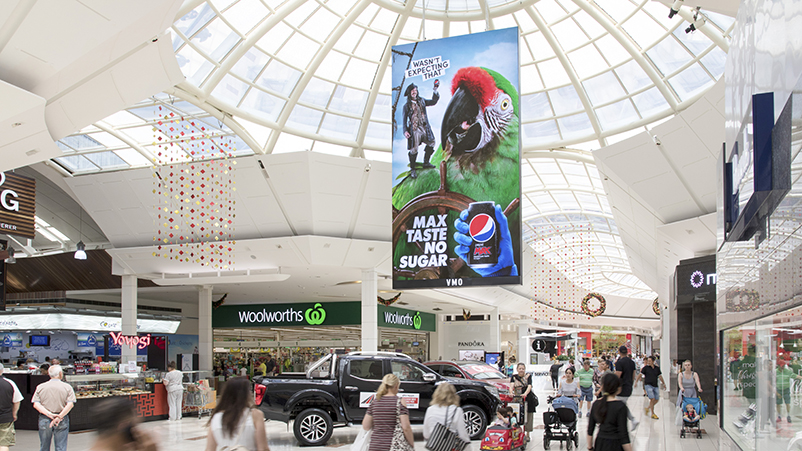Retail OOH: Why you might not be getting the full picture

Asking questions about the placement of screens within shopping centres will enable media buyers to tell their clients exactly where their dollars are ending up, according to Val Morgan Outdoor.
The company says, done correctly, digital out of home within retail environments delivers both brand building and increases the likelihood of driving a sale – right at the point of purchase.
But MD Paul Butler says brands and their representatives must ensure they are reaching people in the right place, at the right time. That is, in the main mall/key thoroughfares, close to major retailers, positioned on approach so that shoppers are directly engaged. Not on the corridor wall, on the way to the toilet or locked away in the car park.
Buy audiences, not bundles
Buyers, says Butler, need to plan and base share on audiences rather than over-index on inventory from individual providers.
“It’s about buying the best screens that will deliver campaign objectives regardless of the provider - that’s the first step,” says Butler.
Shopping centres provide a common weekly metric - cumulative audience footfall - enabling brands and buyers to gauge audience share.
Some buyers are cutting deals with single providers rather than buying the best audiences for clients.
“There are time pressures, there are preferential partnerships in place,” he says. “Agencies find it hard to navigate the space.
While the Outdoor Media Association is working on a common digital audience metric, Butler suggests, the value of certain elements of a retail buy are not currently being evaluated.
Transparency: All screens are not equal
A big part of that equation is that all screens are not equal, says Butler.
“Buying more screens does not necessarily mean you are buying more audience,” he suggests. “Screen placement matters, not overall volume. Strategically placed screens deliver the majority of a centre’s footfall.”
That is, buying screens that directly face the audience.
“Our eye-tracking research demonstrates that front-facing screens are twice as engaging as screens that are parallel to the audience,” Butler claims.
Val Morgan Outdoor has internal front-facing screens, he adds, whereas competitors bundle in less effective parallel screens and screens outside of the retail environment, i.e. in car parks and basements.
“The questions that need to be asked are: understand where your screens are placed and make sure you have transparency around that placement.”
Otherwise, he says brands may think they are advertising in a high footfall premium environment in the centre of the mall, “but they could actually be on a parallel screen in a corridor in the basement car park.”
Asking the question, Butler says, puts the onus on the asset owners to provide transparency for brands and buyers, enabling them to ascertain the true value of what they are being sold.
Butler believes the same rigour should be applied to ‘bundled’ deals, where buyers may perceive value from buying volume inventory, “but are not really sure what it is they have been sold,” he says.
“The client will receive a more effective outcome if they know where they have bought,” says Butler, suggesting a bundled deal may simply end up creating wastage by delivering placements on excess screens in the same centre.
“That won’t contribute to delivering campaign objectives,” says Butler. “Our view on bundles is that if you are prepared to throw it in for free, it’s probably not worth much.”
Check your rotations, evaluate your creative
Butler believes buying solely digital screens in common mall areas helps ensure premium placement - because the cost of rolling out digital screens means asset owners have already carefully assessed the best locations. Moreover, he says VMO’s eye-tracking research has proven digital screens to be 50 per cent more engaging than static panels.
Butler adds that full motion capabilities tell better brand stories. But he urges buyers and brands to check they are getting what they pay for in terms of rotations and ensure ROI is being delivered through third party verified playback data.
Content is also beneficial as part of the advertising loop as it helps draw more viewer attention.
Marketers using VMO’s facial recognition audience tool ‘DART’, says Butler, are also able to see how a specific creative has performed, to better understand what is drawing attention from audiences and overall campaign performance.
Think retail for performance and brand
Butler says retail, particularly in a sluggish economy “is such an important place for brands,” because it provides mass audiences who are in that environment to spend money on goods.
“Retail is the primary place for a marketer to influence the sales process and also attract new audiences to their brands,” says Butler.
“But the key is to properly understand the audience and screen placement aspect. Because that is what delivers ROI.”
Retail DOOH buying checklist
For brands and buyers considering retail OOH, Val Morgan Outdoor suggest the following checklist:
- Viewability: Make sure the screens you are buying are front facing, at floor or eye level or bulkhead
- Full-motion digital: Make sure screens and creative are full-motion digital and include content to maximise audience engagement
- Transparency: Make sure you receive a site list and understand where your placements are
- Location: Make sure placement is within the main common mall area, where all the shoppers are and where there is dwell time
- Beware: That bundled inventory is unlikely to be premium
- Verify: Always ask for proof of delivery and third-party verification.
- Measurement: Use facial recognition technology to measure campaign engagement and creative insights
Want to reach more shoppers just as they are about to spend money?
Speak to Val Morgan Outdoor. We’ll give you the full picture.
